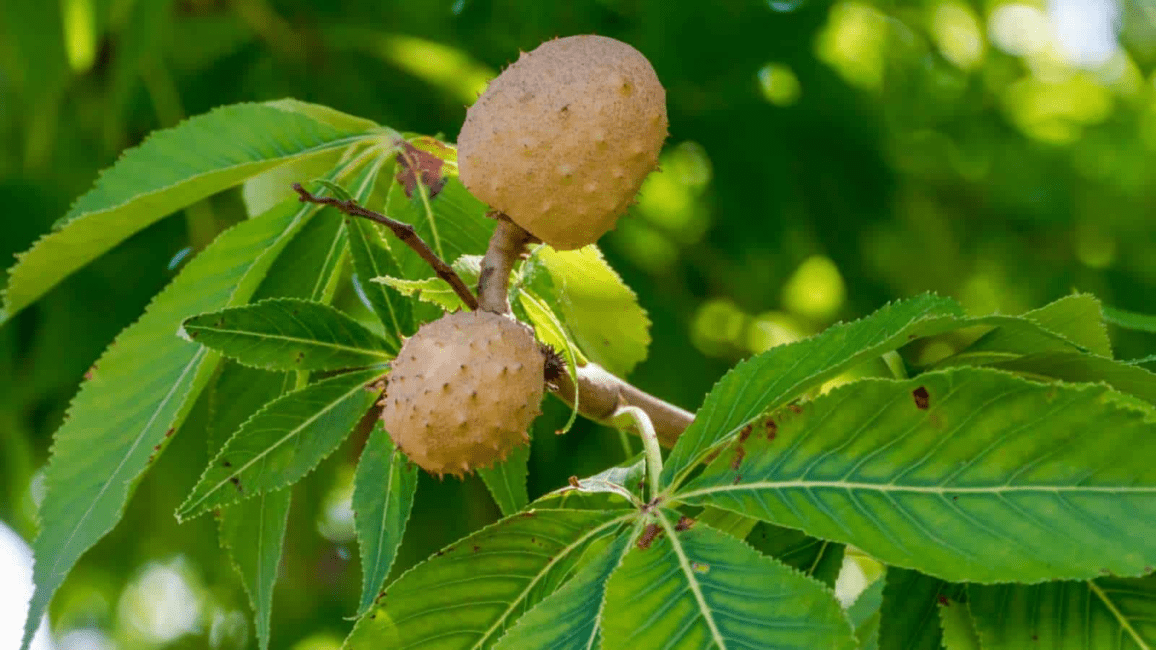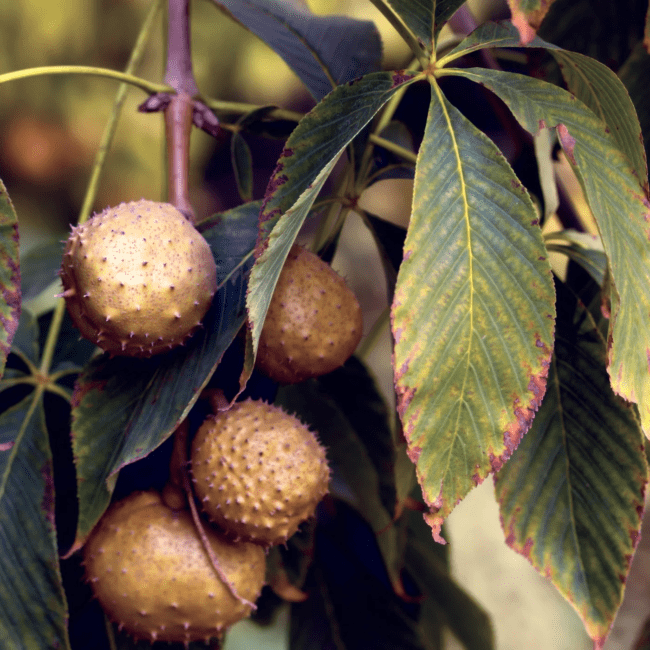Aesculus glabra, commonly known as Ohio buckeye, is a deciduous tree native to the eastern United States. It belongs to the Sapindaceae family and is celebrated for its distinctive foliage, showy spring flowers, and ornamental fruit.
Ohio buckeye typically grows to heights of 15 to 25 meters, with a rounded crown and a straight trunk. The leaves are palmately compound, consisting of five to seven leaflets arranged like fingers on a hand. The leaflets are dark green in color and have serrated margins. In the fall, the foliage turns a vibrant yellow color before dropping, adding to the tree’s ornamental value.
During the spring, Ohio buckeye produces upright clusters of small, yellowish-green flowers. The flowers are borne on long stalks and are highly attractive to pollinators such as bees and butterflies. The blooms give way to spherical fruits known as buckeyes, which are enclosed in spiky husks. The fruits are inedible and contain toxic compounds, earning the tree its common name of “buckeye.”
Ohio buckeye is typically found in moist, well-drained soils in woodlands, ravines, and along stream banks. It thrives in partial shade but can tolerate full sun as well. The tree is known for its tolerance of a wide range of soil types, including clay, loam, and sand.
In landscaping, Ohio buckeye is valued for its ornamental qualities and is often planted as a shade tree in parks, gardens, and urban landscapes. Its attractive foliage, showy flowers, and interesting fruit make it a standout feature in any setting.
While Ohio buckeye is primarily grown for its ornamental value, it also has historical uses in traditional medicine. Indigenous peoples of North America reportedly used various parts of the tree to treat a range of ailments, although modern herbalists generally avoid using it due to its toxic properties.
Overall, Aesculus glabra is a versatile and attractive tree species that adds beauty and interest to landscapes throughout the eastern United States. With its distinctive foliage, showy flowers, and interesting fruit, Ohio buckeye is a valuable addition to any garden or natural setting.
The Botanical Description of Aesculus glabra
Aesculus glabra, commonly known as Ohio buckeye, is a deciduous tree native to North America. Here are ten botanical descriptions:
1. Height: Ohio buckeye trees typically reach heights of 20 to 40 feet, with some specimens growing taller under optimal conditions.
2. Bark: The bark of Aesculus glabra is smooth and gray when young, developing distinctive fissures and ridges as the tree matures.
3. Leaves: The leaves of Ohio buckeye are palmately compound, consisting of five to seven leaflets arranged in a fan-like pattern.
4. Flowers: In spring, Ohio buckeye trees produce clusters of showy, yellow-green flowers with tubular petals, attracting pollinators such as bees and butterflies.
5. Fruit: The fruit of Aesculus glabra is a smooth, round capsule containing one or two shiny brown seeds, known as buckeyes.
6. Growth Habit: Ohio buckeye trees have a rounded canopy with dense foliage, providing shade and ornamental value in landscapes.
7. Fall Color: In autumn, the leaves of Aesculus glabra turn vibrant shades of yellow, orange, and red, adding to its aesthetic appeal.
8. Habitat: Ohio buckeye trees prefer moist, well-drained soils and can be found in a variety of habitats, including woodlands, stream banks, and slopes.
9. Wildlife Value: The seeds of Aesculus glabra are eaten by squirrels and other wildlife, contributing to the tree’s ecological importance.
10. Cultivation: Ohio buckeye is cultivated for its ornamental value in gardens and parks, as well as for its potential use in reforestation and landscaping projects.
The Geographic Distribution of Aesculus glabra

Aesculus glabra, or Ohio buckeye, is native to a specific geographic region in North America. Here are twelve aspects of its distribution:
1. North America: Ohio buckeye is native to eastern and central North America, primarily in the United States.
2. States: The natural range of Aesculus glabra includes states such as Ohio, Indiana, Illinois, Kentucky, Tennessee, and parts of neighboring states.
3. Habitat: Ohio buckeye trees are found in a variety of habitats, including forests, woodlands, floodplains, and riverbanks.
4. Soil Preferences: Aesculus glabra thrives in moist, well-drained soils, but can tolerate a range of soil types, including clay and loam.
5. Climate: Ohio buckeye trees prefer temperate climates with moderate rainfall and seasonal variations in temperature.
6. Altitude: Aesculus glabra is typically found at lower elevations, although it may occur at higher elevations in certain regions.
7. Ecological Role: Ohio buckeye trees play a valuable ecological role in forest ecosystems, providing habitat and food for wildlife.
8. Human Impact: Habitat loss and fragmentation due to urbanization, agriculture, and land development have affected the distribution of Aesculus glabra in some areas.
9. Conservation Status: While Ohio buckeye is not considered globally threatened, conservation efforts may focus on preserving its native habitats and genetic diversity.
10. Cultivation: Aesculus glabra is cultivated for ornamental purposes in gardens, parks, and arboretums, contributing to its distribution beyond its native range.
11. Range Expansion: Ohio buckeye trees may be planted outside of their native range for landscaping or reforestation purposes, potentially expanding their distribution.
12. Naturalization: In some regions, Ohio buckeye trees may naturalize and establish self-sustaining populations outside of their native range.
Understanding the geographic distribution of Aesculus glabra provides insights into its natural habitat, ecological significance, and potential for cultivation in landscaping and restoration projects.
The Chemical Composition of Aesculus glabra
Aesculus glabra, or Ohio buckeye, contains various chemical compounds that contribute to its medicinal properties and potential uses. Here are thirteen key components:
1. Aescin: Aesculus glabra contains aescin, a bioactive compound with anti-inflammatory and venotonic properties, commonly used in traditional medicine.
2. Flavonoids: Ohio buckeye is rich in flavonoids, which have antioxidant and anti-inflammatory effects, contributing to its therapeutic potential.
3. Tannins: The presence of tannins in Aesculus glabra provides astringent properties, which may be beneficial for wound healing and skin conditions.
4. Saponins: Ohio buckeye contains saponins, which have expectorant and antimicrobial properties, making them useful in respiratory and skin care products.
5. Coumarins: Some varieties of Aesculus glabra may contain coumarins, which have anticoagulant and vasodilator effects, potentially benefiting cardiovascular health.
6.Phenolic Compounds: Ohio buckeye contains phenolic compounds with antioxidant properties, helping to neutralize harmful free radicals and protect against oxidative stress.
7. Sterols: Aesculus glabra is a natural source of sterols, which may have cholesterol-lowering and anti-inflammatory effects, supporting overall health.
8. Alkaloids: Some alkaloids may be present in Aesculus glabra, although their specific effects and concentrations may vary among different parts of the plant.
9. Terpenoids: Ohio buckeye may contain terpenoids, which have diverse biological activities, including antimicrobial, anti-inflammatory, and analgesic effects.
10. Essential Oils: Certain varieties of Aesculus glabra may produce essential oils with aromatic and therapeutic properties, suitable for use in aromatherapy and herbal medicine.
11. Carbohydrates: Ohio buckeye contains carbohydrates, providing energy and nutritional support for wildlife that consume its seeds.
12. Minerals: Aesculus glabra seeds are rich in minerals such as calcium, magnesium, and phosphorus, contributing to their nutritional value.
13. Proteins: While present in smaller quantities, proteins found in Aesculus glabra seeds provide essential amino acids necessary for growth and development.
Read Also: Chiggers: Description, Damages Caused, Control and Preventive Measures
The Medicinal Health Benefits Of Aesculus glabra (Ohio Buckeye)

1. Venous Insufficiency: Aesculus glabra extract has been used traditionally to alleviate symptoms of venous insufficiency, such as swelling, pain, and varicose veins.
2. Hemorrhoids: Topical application of Ohio buckeye preparations may help reduce inflammation and discomfort associated with hemorrhoids.
3. Edema: Aesculus glabra supplements or topical preparations may have diuretic effects, promoting fluid balance and reducing edema.
4. Chronic Venous Disorders: Ohio buckeye extract may improve symptoms of chronic venous disorders, including leg pain, heaviness, and cramps.
5. Varicose Veins: Regular use of Aesculus glabra supplements or topical creams may help strengthen vein walls and reduce the appearance of varicose veins.
6. Wound Healing: Ohio buckeye extract or ointments may promote wound healing by accelerating tissue repair and reducing inflammation.
7. Anti-Inflammatory Action: Aesculus glabra contains compounds with anti-inflammatory properties, potentially benefiting inflammatory conditions such as arthritis and dermatitis.
8. Antioxidant Protection: The antioxidants present in Ohio buckeye help neutralize free radicals, protecting cells from oxidative damage and supporting overall health.
9. Respiratory Health: Aesculus glabra preparations may help alleviate respiratory symptoms such as cough, congestion, and bronchial irritation.
10. Circulatory Support: Ohio buckeye extract may support healthy circulation by improving blood flow and reducing the risk of cardiovascular disorders.
11. Menstrual Disorders: Some traditional uses of Aesculus glabra include alleviating symptoms of menstrual disorders such as cramps, bloating, and mood swings.
12. Antimicrobial Effects: Compounds found in Ohio buckeye may exhibit antimicrobial activity against bacteria, viruses, and fungi, contributing to immune health.
13. Anti-Edematous Effects: Aesculus glabra preparations may help reduce edema and swelling associated with inflammatory conditions or fluid retention.
14. Analgesic Properties: Ohio buckeye extracts or creams may have analgesic effects, providing relief from pain associated with musculoskeletal injuries or conditions.
15. Skin Care: Topical application of Aesculus glabra preparations may improve skin tone, texture, and elasticity, enhancing overall skin health.
16. Antispasmodic Action: Some studies suggest that Ohio buckeye may have antispasmodic effects, relieving muscle cramps and spasms.
17. Immune Modulation: Compounds present in Aesculus glabra may modulate immune function, helping to regulate inflammatory responses and enhance immune surveillance.
The Methods of Usage to Achieve the Provided Health Benefits Of Aesculus glabra (Ohio Buckeye)
To achieve the medicinal health benefits of Aesculus glabra, various methods of usage have been employed. Here are twelve common approaches:
1. Oral Supplements: Ohio buckeye supplements in capsule or tablet form provide a convenient way to incorporate its medicinal properties into daily routines.
2. Topical Creams: Creams or ointments containing Aesculus glabra extract can be applied directly to the skin to address specific concerns such as varicose veins or wounds.
3. Tinctures: Liquid extracts of Ohio buckeye can be diluted in water or juice for oral consumption or used topically as compresses or washes.
4. Herbal Teas: Brewing dried Aesculus glabra leaves or bark into a tea allows for internal consumption of its beneficial compounds, promoting circulatory and respiratory health.
5. Poultices: Applying crushed or powdered Ohio buckeye leaves to affected areas can help reduce inflammation, pain, and swelling associated with musculoskeletal injuries.
6. Bath Soaks: Adding Aesculus glabra extract or infusion to bathwater can soothe sore muscles, improve circulation, and promote relaxation.
7. Inhalation: Inhaling steam infused with Ohio buckeye essential oil or dried leaves may help alleviate respiratory congestion and promote respiratory health.
8. Mouthwashes: Gargling with a solution of Aesculus glabra infusion or tincture may help reduce oral inflammation, soothe sore throats, and support oral hygiene.
9. Compresses: Applying soaked cloths or bandages infused with Aesculus glabra extract to swollen or inflamed areas can help reduce edema and promote healing.
10. Aromatherapy: Diffusing Ohio buckeye essential oil in a room or inhaling it directly from a cloth may promote relaxation, relieve stress, and improve mood.
11. Massage Oils: Blending Aesculus glabra extract with carrier oils such as coconut or jojoba oil creates a massage oil that can improve circulation and relieve muscle tension.
12. Dietary Incorporation: Including foods rich in Ohio buckeye seeds or extracts in the diet, such as buckeye flour or supplements, can provide systemic health benefits.
By incorporating these methods of usage into daily routines, individuals can effectively harness the medicinal health benefits of Aesculus glabra while promoting overall well-being.
The Side Effects Of Using Aesculus glabra Medicinal Plant
While Aesculus glabra offers various medicinal benefits, it’s essential to be aware of potential side effects and precautions. Here are fourteen considerations:
1. Skin Irritation: Direct contact with Ohio buckeye leaves, bark, or sap may cause skin irritation or allergic reactions in sensitive individuals.
2. Gastrointestinal Upset: Oral consumption of Aesculus
glabra supplements or teas may cause gastrointestinal discomfort, such as nausea, vomiting, or diarrhea.
3. Toxicity: Certain parts of the Ohio buckeye plant, particularly the seeds, contain toxic compounds that can cause severe poisoning if ingested in large quantities.
4. Allergic Reactions: Some individuals may be allergic to Aesculus glabra or its components, experiencing symptoms such as itching, swelling, or difficulty breathing.
5. Pregnancy and Lactation: Pregnant or breastfeeding women should avoid using Ohio buckeye medicinally due to potential risks to the developing fetus or nursing infant.
6. Children and Pets: Ohio buckeye products should be kept out of reach of children and pets to prevent accidental ingestion, which can lead to toxicity and adverse effects.
7. Drug Interactions: Aesculus glabra supplements may interact with certain medications, particularly blood thinners or antiplatelet drugs, increasing the risk of bleeding.
8. Liver Health: Individuals with liver conditions or impaired liver function should use caution when using Ohio buckeye supplements, as they may affect liver enzymes.
9. Surgery: Ohio buckeye supplements should be discontinued at least two weeks before scheduled surgery to reduce the risk of excessive bleeding during the procedure.
10. Toxicity Symptoms: Symptoms of Aesculus glabra poisoning may include nausea, vomiting, diarrhea, dizziness, weakness, convulsions, and respiratory depression.
11. Cardiovascular Effects: High doses of Ohio buckeye preparations may cause cardiovascular effects such as hypotension, bradycardia, or irregular heart rhythm.
12. Neurological Symptoms: In severe cases of Aesculus glabra poisoning, individuals may experience neurological symptoms such as confusion, seizures, or coma.
13. Renal Damage: Toxic compounds present in Ohio buckeye seeds may cause kidney damage or renal failure if ingested in large quantities.
14. Fatalities: While rare, severe cases of Aesculus glabra poisoning can be fatal, particularly in children or pets who ingest the toxic seeds.
Read Also: How To Grow, Use and Care For Threeawn Grass (Aristida Spp.)
The Scientific Research and Studies of Aesculus glabra

1. Venotonic Activity: Studies have demonstrated the venotonic effects of Ohio buckeye extract, supporting its traditional use in venous insufficiency and related conditions.
2. Anti-Inflammatory Effects: Aesculus glabra has shown promising anti-inflammatory effects in preclinical studies, attributed to its aescin and flavonoid content.
3. Antioxidant Properties: Research indicates that Ohio buckeye extract exhibits antioxidant activity, protecting cells from oxidative damage and supporting overall health.
4. Wound Healing Potential: Some studies suggest that Aesculus glabra preparations may promote wound healing by enhancing collagen synthesis and angiogenesis.
5. Circulatory Benefits: Ohio buckeye extract may improve microcirculation and capillary permeability, contributing to its therapeutic effects on venous disorders.
6. Safety Profile: Clinical trials evaluating the safety of Aesculus glabra supplements have reported low incidences of adverse effects, supporting their tolerability and use.
The Safety Precautions and Recommendations In Using Aesculus glabra Medicinal Plant
1. Source Quality: Obtain Aesculus glabra products from reputable suppliers to ensure purity, potency, and safety.
2. Dosage Guidance: Adhere to recommended dosage guidelines provided by healthcare professionals or product labels.
3. Identification: Properly identify Ohio buckeye trees and products to avoid confusion with similar-looking plants or toxic species.
4. Avoid Toxic Parts: Refrain from consuming Ohio buckeye seeds or other toxic parts of the plant, which can cause severe poisoning.
5. Allergy Testing: Perform a patch test before using Aesculus glabra topically to check for potential allergic reactions.
6. Pregnancy and Lactation: Pregnant or breastfeeding women should avoid using Ohio buckeye products due to insufficient safety data.
7. Medical Conditions: Individuals with pre-existing medical conditions should consult with a healthcare provider before using Aesculus glabra medicinally.
8. Drug Interactions: Be aware of potential interactions between Ohio buckeye supplements and medications, particularly blood thinners or antiplatelet drugs.
9. Monitoring Side Effects: Monitor for any adverse reactions or side effects when using Aesculus glabra, and discontinue use if any occur.
10. Storage: Store Aesculus glabra products safely out of reach of children and pets, away from direct sunlight and moisture.
11. Disposal: Dispose of Ohio buckeye plant parts or products properly to prevent accidental ingestion by humans or animals.
12. Seek Medical Attention: If you experience severe symptoms or allergic reactions after using Aesculus glabra, seek medical attention immediately.
By following these safety precautions and recommendations, individuals can minimize risks and ensure the safe and effective use of Aesculus glabra for medicinal purposes.
FAQs About Aesculus glabra Medicinal Plant
1. Is Aesculus glabra safe for consumption?
Ohio buckeye seeds contain toxic compounds and should not be consumed.
2. Can Aesculus glabra be used topically?
Yes, Ohio buckeye preparations can be used topically for certain purposes, but caution is advised.
3. Are there any known drug interactions with Aesculus glabra?
There may be potential drug interactions with Ohio buckeye, particularly with medications affecting blood clotting.
4. How can Aesculus glabra be used in herbal medicine?
Aesculus glabra has been traditionally used in herbal medicine for its venotonic and anti-inflammatory properties.
5. What precautions should pregnant or breastfeeding women take with Aesculus glabra?
Pregnant or breastfeeding women should avoid Ohio buckeye due to potential risks to the fetus or nursing infant.
6. Can Aesculus glabra be grown at home?
Yes, Ohio buckeye trees can be grown at home in suitable conditions, but caution is advised due to their toxicity.
7. What are the main toxic compounds in Aesculus glabra?
The main toxic compounds in Ohio buckeye seeds are glycosides, which can cause severe poisoning if ingested.
8. Are there any known cases of Aesculus glabra poisoning?
Yes, there have been documented cases of Ohio buckeye poisoning, particularly from ingestion of the seeds.
9. How should Aesculus glabra products be stored?
Ohio buckeye products should be stored safely out of reach of children and pets, away from direct sunlight and moisture.
10. Can Aesculus glabra be used for pets?
No, Ohio buckeye should not be used for pets due to its toxicity.
11. What should I do if I suspect Aesculus glabra poisoning?
If you suspect Ohio buckeye poisoning, seek medical attention immediately and provide as much information as possible about the exposure.
12. Are there any known cases of allergic reactions to Aesculus glabra?
Yes, some individuals may experience allergic reactions to Ohio buckeye, particularly with topical use.
13. Can Aesculus glabra be used for skin conditions?
Topical application of Ohio buckeye preparations may be beneficial for certain skin conditions, but caution is advised.
14. How long does it take for Aesculus glabra supplements to take effect?
The time it takes for Ohio buckeye supplements to take effect may vary depending on the individual and the specific health condition being addressed.
15. Can Aesculus glabra be used in combination with other herbs or medications?
Combining Ohio buckeye with other herbs or medications should be done under the guidance of a healthcare professional to avoid potential interactions or adverse effects.
Read Also:





